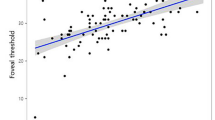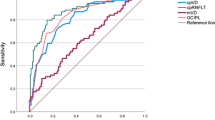Abstract
Objectives
To investigate the correlation of contrast sensitivity with macular region ganglion cell/inner plexiform layer (GC/IPL) thickness and damage location in open-angle glaucoma (OAG) of varying severity.
Methods
Cross-sectional study with 106 patients (203 eyes) who had OAG. Contrast sensitivity of each eye evaluated by quick contrast sensitivity function test based on intelligent algorithm. The GC/IPL thickness measured with optical coherence tomography; six sectors were delineated for localization of damage area. All eyes were grouped by the healthy macular sector and divided into pre-perimetric, early, moderate, and advanced stages, according to severity of visual field impairment.
Results
Mean GC/IPL thickness in the entire macular region and each sector were correlated with parameters that reflected contrast sensitivity (p < 0.01). The structure-function correlations were stronger nasally compared with temporally, and superiorly compared with inferiorly. Eyes with normal structure in inferior temporal sector had less visual field (p' = 0.024) and macular damage (p′ = 0.034) compared with eyes that had healthy superior nasal sector; there was no difference in contrast sensitivity (p = 0.898). The structure-function correlations were significant in early, moderate, and advanced glaucoma (p < 0.05) but not in pre-perimetric glaucoma (p = 0.116).
Conclusions
GC/IPL thinning in all sectors of the macular region in OAG was correlated with contrast sensitivity impairment, whereas the inferior temporal sector was least affected. Contrast sensitivity was supported as a severity evaluation indicator of early, moderate, and advanced glaucoma, but not of pre-perimetric glaucoma.
This is a preview of subscription content, access via your institution
Access options
Subscribe to this journal
Receive 18 print issues and online access
$259.00 per year
only $14.39 per issue
Buy this article
- Purchase on Springer Link
- Instant access to full article PDF
Prices may be subject to local taxes which are calculated during checkout


Similar content being viewed by others
Data availability
All data generated or analyzed during this study are included in this published article and its supplementary information files.
References
Ginsburg AP. Contrast sensitivity and functional vision. Int Ophthalmol Clin. 2003;43:5–15.
Thompson AC, Chen H, Miller ME, Webb CC, Williamson JD, Marsh AP, et al. Association between contrast sensitivity and physical function in cognitively healthy older adults: the brain network and mobility function study. J Gerontol A Biol Sci Med Sci 2023;78:1513–21.
Hu CX, Zangalli C, Hsieh M, Gupta L, Williams AL, Richman J, et al. What do patients with glaucoma see? Visual symptoms reported by patients with glaucoma. Am J Med Sci. 2014;348:403–9.
Eshraghi H, Sanvicente CT, Gogte P, Waisbourd M, Lee D, Manzi RRS, et al. Measuring contrast sensitivity in specific areas of vision - a meaningful way to assess quality of life and ability to perform daily activities in glaucoma. Ophthalmic Epidemiol. 2019;26:301–10.
Lin S, Mihailovic A, West SK, Johnson CA, Friedman DS, Kong X, et al. Predicting visual disability in glaucoma with combinations of vision measures. Transl Vis Sci Technol. 2018;7:22.
Enoch J, Jones L, Taylor DJ, Bronze C, Kirwan JF, Jones PR, et al. How do different lighting conditions affect the vision and quality of life of people with glaucoma? A systematic review. Eye. 2020;34:138–54.
Ichhpujani P, Thakur S, Spaeth GL. Contrast sensitivity and glaucoma. J Glaucoma. 2020;29:71–5.
Fatehi N, Nowroozizadeh S, Henry S, Coleman AL, Caprioli J, Nouri-Mahdavi K. Association of structural and functional measures with contrast sensitivity in glaucoma. Am J Ophthalmol. 2017;178:129–39.
Chien L, Liu R, Girkin C, Kwon M. Higher Contrast requirement for letter recognition and macular RGC+ layer thinning in glaucoma patients and older adults. Invest Ophthalmol Vis Sci. 2017;58:6221–31.
Shamsi F, Liu R, Owsley C, Kwon M. Identifying the retinal layers linked to human contrast sensitivity via deep learning. Invest Ophthalmol Vis Sci. 2022;63:27.
Xian Y, Sun L, Ye Y, Zhang X, Zhao W, Shen Y, et al. The characteristics of quick contrast sensitivity function in keratoconus and its correlation with corneal topography. Ophthalmol Ther. 2023;12:293–305.
Ou WC, Lesmes LA, Christie AH, Denlar RA, Csaky KG. Normal- and low-luminance automated quantitative contrast sensitivity assessment in eyes with age-related macular degeneration. Am J Ophthalmol. 2021;226:148–55.
Joltikov KA, de Castro VM, Davila JR, Anand R, Khan SM, Farbman N, et al. Multidimensional functional and structural evaluation reveals neuroretinal impairment in early diabetic retinopathy. Invest Ophthalmol Vis Sci. 2017;58:BIO277–90.
Joltikov KA, Sesi CA, de Castro VM, Davila JR, Anand R, Khan SM, et al. Disorganization of retinal inner layers (DRIL) and neuroretinal dysfunction in early diabetic retinopathy. Invest Ophthalmol Vis Sci. 2018;59:5481–6.
Joshi P, Dangwal A, Guleria I, Kothari S, Singh P, Kalra JM, et al. Glaucoma in adults-diagnosis, management, and prediagnosis to end-stage, categorizing glaucoma’s stages: a review. J Curr Glaucoma Pr. 2022;16:170–8.
Lesmes LA, Lu ZL, Baek J, Albright TD. Bayesian adaptive estimation of the contrast sensitivity function: the quick CSF method. J Vis. 2010;10:17.1–21.
Zheng H, Wang C, Cui R, He X, Shen M, Lesmes LA, et al. Measuring the contrast sensitivity function using the qCSF method with 10 digits. Transl Vis Sci Technol. 2018;7:9.
Kelly DH. Spatial frequency selectivity in the retina. Vis Res. 1975;15:665–72.
Enroth-Cugell C, Robson JG. The contrast sensitivity of retinal ganglion cells of the cat. J Physiol. 1966;187:517–52.
Pang R, Peng J, Cao K, Sun Y, Pei XT, Yang D, et al. Association between contrast sensitivity function and structural damage in primary open-angle glaucoma. Br J Ophthalmol. 2023. https://doi.org/10.1136/bjo-2023-323539. Epub ahead of print.
Elliott DB. Evaluating visual function in cataract. Optom Vis Sci. 1993;70:896–902.
Perry VH, Cowey A. The ganglion cell and cone distributions in the monkey’s retina: implications for central magnification factors. Vis Res. 1985;25:1795–810.
Curcio CA, Allen KA. Topography of ganglion cells in human retina. J Comp Neurol. 1990;300:5–25.
Sato S, Hirooka K, Baba T, Tenkumo K, Nitta E, Shiraga F. Correlation between the ganglion cell-inner plexiform layer thickness measured with cirrus HD-OCT and macular visual field sensitivity measured with microperimetry. Invest Ophthalmol Vis Sci. 2013;54:3046–51.
Ghita AM, Iliescu DA, Ghita AC, Ilie LA, Otobic A. Ganglion cell complex analysis: correlations with retinal nerve fiber layer on optical coherence tomography. Diagnostics. 2023;13:266.
Kim KE, Park KH. Macular imaging by optical coherence tomography in the diagnosis and management of glaucoma. Br J Ophthalmol. 2018;102:718–24.
Gao J, Provencio I, Liu X. Intrinsically photosensitive retinal ganglion cells in glaucoma. Front Cell Neurosci. 2022;16:992747.
San Laureano J. When is glaucoma really glaucoma? Clin Exp Optom. 2007;90:376–85.
de Moraes CG, Liebmann JM, Medeiros FA, Weinreb RN. Management of advanced glaucoma: Characterization and monitoring. Surv Ophthalmol. 2016;61:597–615.
Stamper RL, Hsu-Winges C, Sopher M. Arden contrast sensitivity testing in glaucoma. Arch Ophthalmol. 1982;100:947–50.
Richman J, Zangalli C, Lu L, Wizov SS, Spaeth E, Spaeth GL. The Spaeth/Richman contrast sensitivity test (SPARCS): design, reproducibility and ability to identify patients with glaucoma. Br J Ophthalmol. 2015;99:16–20.
Thakur S, Ichhpujani P, Kumar S, Kaur R, Sood S. Assessment of contrast sensitivity by Spaeth Richman Contrast Sensitivity Test and Pelli Robson Chart Test in patients with varying severity of glaucoma. Eye. 2018;32:1392–400.
Bierings R, de Boer MH, Jansonius NM. Visual performance as a function of luminance in glaucoma: The De Vries-Rose, Weber’s, and Ferry-Porter’s Law. Invest Ophthalmol Vis Sci. 2018;59:3416–23.
Acknowledgements
The authors thank AiMi Academic Services (www.aimieditor.com) for English language editing and review services.
Funding
The study is funded by National Natural Science Foundation of China (82130029 and 82070960). The funding organization had no role in the design or conduct of this research.
Author information
Authors and Affiliations
Contributions
NW contributed to design, acquisition of funding and general supervision of the research group. RP and JTP contributed to design, analysis of results, collection of data and drafting of the manuscript. KC contributed to the data analysis. ZLL and QZ contributed to the manuscript revision. All authors reviewed and edited the manuscript and approved the final version of the manuscript.
Corresponding author
Ethics declarations
Competing interests
ZLL holds intellectual property interests in visual function measurement and rehabilitation technologies, and equity interests in Adaptive Sensory Technology, Inc. (San Diego, CA, USA) and Jiangsu Juehua Medical Technology, Ltd (Jiangsu, China). There is no other conflict of interest in the submission of this manuscript.
Ethics approval
The Medical Ethics Committee of Beijing Tongren Hospital approved all study procedures.
Additional information
Publisher’s note Springer Nature remains neutral with regard to jurisdictional claims in published maps and institutional affiliations.
Rights and permissions
Springer Nature or its licensor (e.g. a society or other partner) holds exclusive rights to this article under a publishing agreement with the author(s) or other rightsholder(s); author self-archiving of the accepted manuscript version of this article is solely governed by the terms of such publishing agreement and applicable law.
About this article
Cite this article
Pang, R., Peng, J., Zhang, Q. et al. Correlation of contrast sensitivity with ganglion cell/inner plexiform layer thickness and damage location in glaucoma with varying severity. Eye (2023). https://doi.org/10.1038/s41433-023-02887-0
Received:
Revised:
Accepted:
Published:
DOI: https://doi.org/10.1038/s41433-023-02887-0



